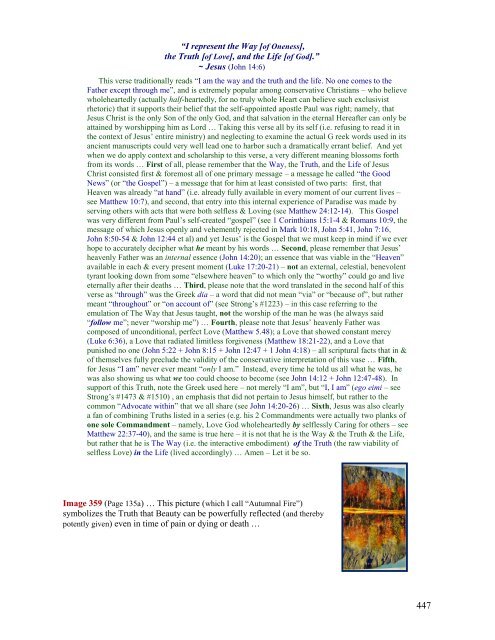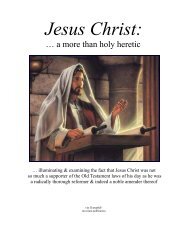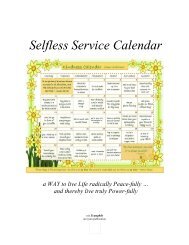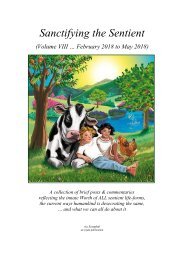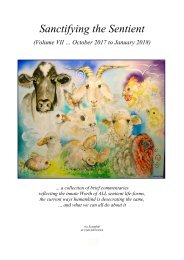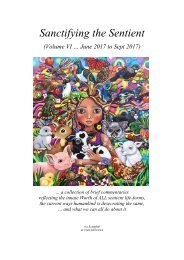- Page 1 and 2:
The Brown Book Commentaries Exposit
- Page 3 and 4:
Dedicated to Truth-Seekers everywhe
- Page 5 and 6:
Introduction & Clarification Hand-m
- Page 7 and 8:
Eternity, Imagination & the Dream T
- Page 9 and 10:
Life: ―… to fill with Trips, Fl
- Page 11 and 12:
PAGE 02 “It is not for you to kno
- Page 13 and 14:
PAGE 03 “It is Now the moment for
- Page 15 and 16:
PAGE 04 “God provides us with eve
- Page 17 and 18:
PAGE 05 “We speak God‟s Wisdom,
- Page 19 and 20:
PAGE 06 “Whoever Does Good is in
- Page 21 and 22:
Image 023 (back of year 2008) … T
- Page 23 and 24:
“Every truly generous act of Givi
- Page 25 and 26:
―The Moon that is full does not f
- Page 27 and 28:
PAGE 08 NOTE: Page 8 displays a vis
- Page 29 and 30:
… Joy is always available. Even t
- Page 31 and 32:
… Revel in the omnipresence of Gr
- Page 33 and 34:
Image 033 (Page 9b) … Here I and
- Page 35 and 36:
Far from being a masochistic call t
- Page 37 and 38:
Image 038 (Page 11b - top) … This
- Page 39 and 40:
Image 042 (Page 12b) … I call thi
- Page 41 and 42:
EVOLVER, with Honor superceding whi
- Page 43 and 44:
Image 043a (Page 13b - top) … My
- Page 45 and 46:
―You can tell you are on your way
- Page 47 and 48:
NOTE: Pages 15b-18 we used to allow
- Page 49 and 50:
PAGE 17 Image 047 (Page 17a) … Th
- Page 51 and 52:
Image 050a (Page 18b - main image)
- Page 53 and 54:
PAGE 20 A Prayer at Sunset I Give T
- Page 55 and 56:
PAGE 21 Image 055 (Page 21a) … Th
- Page 57 and 58:
PAGE 26 ―Communication has no wor
- Page 59 and 60:
―Life‘s two Omniscient Guides:
- Page 61 and 62:
PAGE 29 Image 064 (Page 29a - main
- Page 63 and 64:
PAGE 30 Image 067 (Page 30a) … Th
- Page 65 and 66:
PAGE 32 ―Live Compassion … Insp
- Page 67 and 68:
―Give the Spirit the proper growi
- Page 69 and 70:
It is the Collective Consciousness
- Page 71 and 72:
PAGE 36 ―A symbol … suggests or
- Page 73 and 74:
PAGE 38 Image 074a (Page 38a - atta
- Page 75 and 76:
―I have strong opinions of my own
- Page 77 and 78:
“We have this Treasure in clay ja
- Page 79 and 80:
PAGE 41 ―The greatness of a Man c
- Page 81 and 82:
Image 082 (Page 41b - main) … Thi
- Page 83 and 84:
―Life is not the way it‘s suppo
- Page 85 and 86:
Image 085 (Page 42b) … This is on
- Page 87 and 88:
―All parts of my Self are open to
- Page 89 and 90:
―Even if we lose the details to t
- Page 91 and 92:
Image 089 (Page 44a) … I‘m not
- Page 93 and 94:
PAGE 45 ―The conditions of a (Sag
- Page 95 and 96:
Image 092a&b (Page 45b - top + over
- Page 97 and 98:
Image 094 (Page 46a1 - top) … Thi
- Page 99 and 100:
PAGE 47 Image 096 (Page 47a - upper
- Page 101 and 102:
―Pray with moving feet.‖ ~ Quak
- Page 103 and 104:
“By the tender mercy of our God,
- Page 105 and 106:
PAGE 49 ―Deeds, not Words!‖ ~ L
- Page 107 and 108:
―Believe none of what you hear an
- Page 109 and 110:
Image 104 (Page 50a - top left) …
- Page 111 and 112:
―When you‘ve only one breath le
- Page 113 and 114:
Image 108 (Page 51b - upper right)
- Page 115 and 116:
―Grandma said that the Spirit Min
- Page 117 and 118:
Image 111 (Page 52b - bottom right)
- Page 119 and 120:
Image 113a (Page 53a - bottom right
- Page 121 and 122:
―Love others by Seeing the Truths
- Page 123 and 124:
“How beautiful are the feet of th
- Page 125 and 126:
PAGE 55 Image 120 (Page 55a & b)
- Page 127 and 128:
Image 121 (Page 56a - top) … This
- Page 129 and 130:
―Keep your beacons of True Self w
- Page 131 and 132:
“In God we Live and Move and have
- Page 133 and 134:
―We had the choice along the Way
- Page 135 and 136:
Every small step clears a space beh
- Page 137 and 138:
―Let us go and See for ourselves.
- Page 139 and 140:
―When surrounded by normalcy, fin
- Page 141 and 142:
Image 132a (Page 60b - main) … Th
- Page 143 and 144:
―Succeed with Honor.‖ ~ anonymo
- Page 145 and 146:
“Ask and it will be given you. Se
- Page 147 and 148:
―Love is allWays a work in progre
- Page 149 and 150:
―What you desire to say is not ne
- Page 151 and 152:
Image 140 (Page 62b - bottom) … T
- Page 153 and 154:
Image 141 (Page 63a) … This is a
- Page 155 and 156:
Image 142 (Page 63b - main image)
- Page 157 and 158:
“Everything exposed by the Light
- Page 159 and 160:
―Flow in Peace - for that You Are
- Page 161 and 162:
―I Am dust particles in sunlight
- Page 163 and 164:
―If we do not ever take time, how
- Page 165 and 166:
Image 150 (Page 66a - bottom) … T
- Page 167 and 168:
PAGE 67 ―We can‘t only have the
- Page 169 and 170:
―I do not know what your Destiny
- Page 171 and 172:
PAGE 68 ―It‘s not how many idea
- Page 173 and 174:
―Do or Do not. There is not ‗tr
- Page 175 and 176:
―He who hesitates has had it.‖
- Page 177 and 178:
“It is more Blessed to Give than
- Page 179 and 180:
It is only possible to be Meaning-f
- Page 181 and 182:
“We are born blind so that God‟
- Page 183 and 184:
―The sun shines for everyone.‖
- Page 185 and 186:
―Just because you don't remember
- Page 187 and 188:
―Living the Truth in your Heart w
- Page 189 and 190:
Image 172 (Page 72a - main bottom)
- Page 191 and 192:
―Natural … Now there‘s a tric
- Page 193 and 194:
Image 174 (Page 73a - top) … This
- Page 195 and 196:
―Question with boldness even the
- Page 197 and 198:
“I will choose You, one from a th
- Page 199 and 200:
―Embrace your fears … Have comp
- Page 201 and 202:
―A monk asked Joshu why Bodhidhar
- Page 203 and 204:
―For the scientist who has lived
- Page 205 and 206:
“See that no one repays evil for
- Page 207 and 208:
PAGE 76 ―The Noble Man allWays fi
- Page 209 and 210:
Image 184 (Page 76b - top) … Thes
- Page 211 and 212:
―Gamble everything for Love if yo
- Page 213 and 214:
―An eye is meant to See things. T
- Page 215 and 216:
PAGE 79 ―The important thing [in
- Page 217 and 218:
Image 190 (Page 80a) … This pictu
- Page 219 and 220:
Image 193 (Page 81b - top) … This
- Page 221 and 222:
PAGE 82 ―Be wondrously Awe-filled
- Page 223 and 224:
―There are no patterns in the pre
- Page 225 and 226:
PAGE 83 ―If it ever turned out th
- Page 227 and 228:
―Your Life is a Sacred Journey. I
- Page 229 and 230:
―Frictionless Truth; spinning …
- Page 231 and 232:
―It doesn‘t interest me what yo
- Page 233 and 234:
Image 202 (Page 84b) … This is an
- Page 235 and 236:
―Be true to Self … Trust in Spi
- Page 237 and 238:
―Focus on the Journey rather than
- Page 239 and 240:
―In any gathering, in any chance
- Page 241 and 242:
―As soon as you trust your Self,
- Page 243 and 244:
“Do not be anxious, from morning
- Page 245 and 246:
“God shows no partiality, but in
- Page 247 and 248:
PAGE 88 ―In the blink of an eye,
- Page 249 and 250:
Image 216 (Page 88a - bottom) … T
- Page 251 and 252:
PAGE 89 ―If it isn‘t broken, av
- Page 253 and 254:
Image 220 (Page 89a - bottom) … T
- Page 255 and 256:
Image 221 (Page 89b - top right)
- Page 257 and 258:
Image 223 (Page 90a - top) … This
- Page 259 and 260:
―I have faith in you, in your Pow
- Page 261 and 262:
―One Truth is clear: Whatever IS,
- Page 263 and 264:
―That which does not kill us make
- Page 265 and 266:
“If any want to become my followe
- Page 267 and 268:
―You are meant to Be whatever you
- Page 269 and 270:
―Begun heroically, the Journey do
- Page 271 and 272:
PAGE 94 ―The Vocation of every ma
- Page 273 and 274:
Image 235 (Page 94a - bottom) … T
- Page 275 and 276:
PAGE 95 ―Others can only grow in
- Page 277 and 278:
―In every moment of choice, there
- Page 279 and 280:
Image 239 (Page 95b - bottom) … T
- Page 281 and 282:
―Faith has nothing to do with the
- Page 283 and 284:
―When building a circle of Friend
- Page 285 and 286:
―Better than 1000 useless words i
- Page 287 and 288:
PAGE 98 ―The first step on the Jo
- Page 289 and 290:
―Cheerfully give others more than
- Page 291 and 292:
―The most important quality in a
- Page 293 and 294:
―There is immeasurable Love and P
- Page 295 and 296:
―Know that the bear [living as Tr
- Page 297 and 298:
―The Heart has its reasons, where
- Page 299 and 300:
“Love is from God; everyone who L
- Page 301 and 302:
Image 255 (Page 100b - main image)
- Page 303 and 304:
―Think for yourself. No one else
- Page 305 and 306:
―A Wise Man asks for direction
- Page 307 and 308:
―Forgive both the ignorant and th
- Page 309 and 310:
Concerning profit: ask not for a po
- Page 311 and 312:
―Turn into My place and sit quiet
- Page 313 and 314:
“What you sow does not come to Li
- Page 315 and 316:
From the cradle to the grave, we mu
- Page 317 and 318:
PAGE 104 ―When the defining momen
- Page 319 and 320:
Image 267 (Page 104a - bottom overl
- Page 321 and 322:
“Store up for your selves treasur
- Page 323 and 324:
―What I wish for my Beloved: laug
- Page 325 and 326:
“Be not forgetful to entertain st
- Page 327 and 328:
―To Love someone is to learn the
- Page 329 and 330:
―And what do you Do when you reco
- Page 331 and 332:
―Through Nature we see the powerf
- Page 333 and 334:
Image 279 (Page 107a - top & bottom
- Page 335 and 336:
“Have you discovered the beginnin
- Page 337 and 338:
“Give to the emperor the things t
- Page 339 and 340:
Image 285 (Page 108b - upper right)
- Page 341 and 342:
―Our true Task is to join with th
- Page 343 and 344:
―Old Problem: Being a victim …
- Page 345 and 346:
Image 289 (Page 109b) … This is a
- Page 347 and 348:
―Like and equal are two entirely
- Page 349 and 350:
―Listen to thoughts woven with so
- Page 351 and 352:
Image 296 (Page 111a - bottom) …
- Page 353 and 354:
PAGE 112 ―The best portions of a
- Page 355 and 356:
―Imagination is an intellectual e
- Page 357 and 358:
I believe that the rendering of ser
- Page 359 and 360:
―He was wise enough to see that w
- Page 361 and 362:
The Noble (Wo)Man emanates … an A
- Page 363 and 364:
―You need not think about whether
- Page 365 and 366:
PAGE 115 Image 306 (Page 115a) …
- Page 367 and 368:
“After saying farewell to them, h
- Page 369 and 370:
―If it be a sin to covet honor, I
- Page 371 and 372:
―Truth has many faces, and any on
- Page 373 and 374:
“You will not see me again until
- Page 375 and 376:
―Be never converted from the reli
- Page 377 and 378:
… that to ignore Life‘s ―fact
- Page 379 and 380:
―I knew where Grandma was taking
- Page 381 and 382:
―When a person that one Loves is
- Page 383 and 384:
―When you feel lost or lonely in
- Page 385 and 386:
“Be alert; I have already told yo
- Page 387 and 388:
They sow only for others … They r
- Page 389 and 390:
―Towards the One -- The perfectio
- Page 391 and 392:
―When you recognize the fundament
- Page 393 and 394:
“We walk by Faith, not by sight.
- Page 395 and 396: “Give for alms those things that
- Page 397 and 398: PAGE 123 “There is a Light within
- Page 399 and 400: ―Love is simply the re-discovery
- Page 401 and 402: ―There can only be one Purpose fo
- Page 403 and 404: Image 331 (Page 124b - bottom) …
- Page 405 and 406: ―The Rules: Never go back (the pa
- Page 407 and 408: Image 335 (Page 126a) … This pict
- Page 409 and 410: Image 337 (Page 127a) … This pict
- Page 411 and 412: Image 339 (Page 127b) … This pict
- Page 413 and 414: ―Let the Beauty we Love be what w
- Page 415 and 416: “If you wish to be perfect then g
- Page 417 and 418: PAGE 129 ―A knowledge of the Path
- Page 419 and 420: “In the world you face persecutio
- Page 421 and 422: Image 346 (Page 129b) … This draw
- Page 423 and 424: “Jesus said to them: „Fill the
- Page 425 and 426: “I have said these things to you
- Page 427 and 428: “Those who are well have no need
- Page 429 and 430: ―Our similarities are different.
- Page 431 and 432: Image 351 (Page 131b - top right)
- Page 433 and 434: PAGE 132 ―The gods only go with y
- Page 435 and 436: ―Behave towards offenders as if t
- Page 437 and 438: PAGE 133 ―There is no ‗better w
- Page 439 and 440: ―My Messiah is perched out there
- Page 441 and 442: “When you can undress without bei
- Page 443 and 444: “I will give you the keys to the
- Page 445: ―See more than you are ‗seen‘
- Page 449 and 450: ―If you‘re going to be a bear,
- Page 451 and 452: ―Nature does everything with Purp
- Page 453 and 454: ―Things are exactly as they are m
- Page 455 and 456: ―Let your daily life be such as t
- Page 457 and 458: When given the choice between gentl
- Page 459 and 460: “Where I am going, you cannot fol
- Page 461 and 462: ―Avoid always saying what you kno
- Page 463 and 464: ―Whatever you do, make it positiv
- Page 465 and 466: ―It‘s going to take some crazin
- Page 467 and 468: PAGE 140 “God is a God not of dis
- Page 469 and 470: “For to those who truly Have, mor
- Page 471 and 472: ―God is not only omnipresent, vib
- Page 473 and 474: Image 376 (Page 141a - center) …
- Page 475 and 476: ―I believe in you completely & su
- Page 477 and 478: ―Give us Peace.‖ ~ Latin Saying
- Page 479 and 480: “If you have Faith the size of a
- Page 481 and 482: “Blessed is she who Believed, for
- Page 483 and 484: PAGE 143 ―There is no beginning t
- Page 485 and 486: ―For in the dew of little things
- Page 487 and 488: “He also saw a poor widow put in
- Page 489 and 490: “I do not count my life of any va
- Page 491 and 492: ―To be Care-full, avoid being car
- Page 493 and 494: PAGE 145 ―There is no such thing
- Page 495 and 496: “Whoever is from God hears the wo
- Page 497 and 498:
Image 396 (Page 145b - top right)
- Page 499 and 500:
―To my Friend - I am your Friend
- Page 501 and 502:
PAGE 147 ―Reality is a bunch of s
- Page 503 and 504:
―Let your Vision be world-embraci
- Page 505 and 506:
PAGE 148 ―The way that can be des
- Page 507 and 508:
―Now is the time to carry forward
- Page 509 and 510:
“Live in peace, and the God of Lo
- Page 511 and 512:
―Let each exalt in his own martyr
- Page 513 and 514:
Image 407 (Page 149b) … This pict
- Page 515 and 516:
―Information is not Knowledge unt
- Page 517 and 518:
“Our Father, who art in Heaven, h
- Page 519 and 520:
“He entered the synagogue and tau
- Page 521 and 522:
And remember to do so more with wor
- Page 523 and 524:
―A little consideration - a littl
- Page 525 and 526:
―When waking in the morning, reme
- Page 527 and 528:
―Sometimes, if you stand on the r
- Page 529 and 530:
―Planning for the future is like
- Page 531 and 532:
―The search for one who shall rec
- Page 533 and 534:
PAGE 153 ―If you want to find a g
- Page 535 and 536:
―Talk less and Do more and when y
- Page 537 and 538:
Love whatever is closest by, as ful
- Page 539 and 540:
“There is no fear in Love - and p
- Page 541 and 542:
“For by Grace you have been saved
- Page 543 and 544:
―If you truly desire it, then you
- Page 545 and 546:
“Live as Children of Light - for
- Page 547 and 548:
―It is possible to decrease the s
- Page 549 and 550:
―The mark of ignorance is the dep
- Page 551 and 552:
PAGE 157 ―I will write Peace on y
- Page 553 and 554:
“If I do not go away, the Advocat
- Page 555 and 556:
―Triumph and disaster are both im
- Page 557 and 558:
―Divine Communications are as fol
- Page 559 and 560:
Image 437 (Page 158a1 - top) … Th
- Page 561 and 562:
―Twenty years from now you will b
- Page 563 and 564:
PAGE 159 ―Even the wise cannot kn
- Page 565 and 566:
Image 447 (Page 159a - bottom right
- Page 567 and 568:
―Are you reveling or swaying?‖
- Page 569 and 570:
―Just as every flower wilts and e
- Page 571 and 572:
―If I never met you, I would have
- Page 573 and 574:
―There are two ways to live your
- Page 575 and 576:
―Everything is possible to an ope
- Page 577 and 578:
Image 460 (Page 162a) … This pict
- Page 579 and 580:
“God opposes the proud and gives
- Page 581 and 582:
―Each atomic particle is a family
- Page 583 and 584:
PAGE 164 ―One can make a day of a
- Page 585 and 586:
Image 468 (Page 165a - top right)
- Page 587 and 588:
“I am the Light that is within ev
- Page 589 and 590:
―We feasted on Love … every ato
- Page 591 and 592:
“Let your adornment be the Inner
- Page 593 and 594:
―Received with Wonder -- raised l
- Page 595 and 596:
Image 477 (Page 168a1 - top) … Th
- Page 597 and 598:
PAGE 169 ―The best mirror is an o
- Page 599 and 600:
―And the Earth mother came to me
- Page 601 and 602:
“God is Love, and those who abide
- Page 603 and 604:
Image 484 (Page 171a) … This pict


